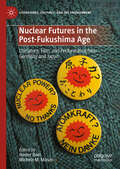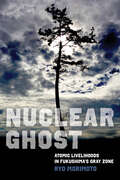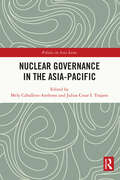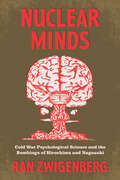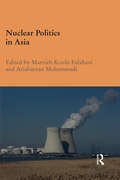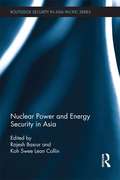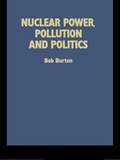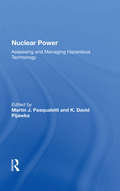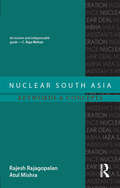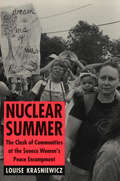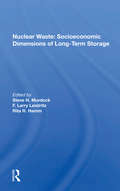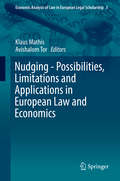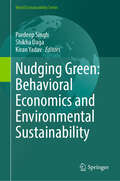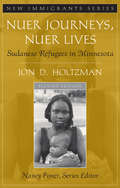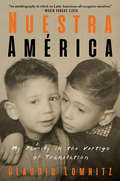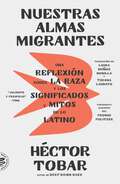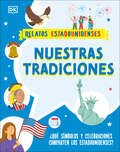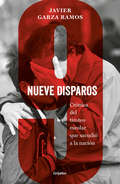- Table View
- List View
Nuclear Futures in the Post-Fukushima Age: Literature, Film, and Performance from Germany and Japan (Literatures, Cultures, and the Environment)
by Hester Baer Michele M. MasonThis groundbreaking volume explores new artistic forms that emerged in German-speaking Europe and Japan in the wake of the 2011 Fukushima nuclear power plant disaster. Considering the cultural specificity of post-3.11 literature, poetry, theater, and film, while also attending to moments of crossing, hybridity, and transference, Nuclear Futures in the Post-Fukushima Age offers a critical model for examining the intertwining of transnational connection and ecological contamination in a global present marked by renewed nuclear threat. Bringing together incisive readings by eminent scholars of Germany and Japan as well as a newly translated work by Yōko Tawada, the volume offers a comparative humanities approach that is essential for reframing debates about environmental crisis and nuclear risk.
Nuclear Ghost: Atomic Livelihoods in Fukushima's Gray Zone (California Series in Public Anthropology #56)
by Ryo Morimoto"There is a nuclear ghost in Minamisōma." This is how one resident describes a mysterious experience following the 2011 nuclear fallout in coastal Fukushima. Investigating the nuclear ghost among the graying population, Ryo Morimoto encounters radiation’s shapeshifting effects. What happens if state authorities, scientific experts, and the public disagree about the extent and nature of the harm caused by the accident? In one of the first in-depth ethnographic accounts of coastal Fukushima written in English, Nuclear Ghost tells the stories of a diverse group of residents who aspire to live and die well in their now irradiated homes. Their determination to recover their land, cultures, and histories for future generations provides a compelling case study for reimagining relationality and accountability in the ever-atomizing world.
Nuclear Governance in the Asia-Pacific (Politics in Asia)
by Mely Caballero-Anthony Julius Cesar I. TrajanoThe contributors to this book explore approaches to building a framework for nuclear governance in the Asia-Pacific – encompassing nuclear safety, security, and safeguards/non-proliferation. Nuclear governance collaboration offers an avenue for states in the Asia-Pacific to tackle the emerging opportunities for and challenges to the peaceful uses of nuclear energy and the civilian applications of nuclear and radioactive materials. The nature of national actions, bilateral initiatives and regional cooperation in capacity building taking place in East Asia provides a good foundation to pursue a more robust collaborative framework for nuclear governance in the wider Asia-Pacific region. The contributors to this book explore the most critical nuclear safety, security and non-proliferation issues faced by states in the Asia-Pacific and the growing cooperation spearheaded by Southeast Asian countries, China, Japan, South Korea and the United States. This book is a valuable read for academics working on security and strategic studies, international relations, non-traditional security issues as well as nuclear-related issues.
Nuclear Meltdown, USA: Could Japan's Power Plant Disaster Happen Here?
by Chanan TigaySitting near four significant fault lines on the coastline of California, Diablo Canyon is just one of 65 nuclear power plants in the United States. After the nuclear meltdown in Fukushima, Japan, Americans are now asking, "Could it happen here?" This e-book original, based on an in-depth investigation commissioned exclusively for Prevention magazine by the award-winning photojournalist team of Chanan Tigay and Colin Finlay, explores the risks--to our planet and ourselves--of the plant and its impact on the people who live and work in the "happiest place in America."
Nuclear Minds: Cold War Psychological Science and the Bombings of Hiroshima and Nagasaki
by Ran ZwigenbergHow researchers understood the atomic bomb’s effects on the human psyche before the recognition of Post-Traumatic Stress Disorder. In 1945, researchers on a mission to Hiroshima with the United States Strategic Bombing Survey canvassed survivors of the nuclear attack. This marked the beginning of global efforts—by psychiatrists, psychologists, and other social scientists—to tackle the complex ways in which human minds were affected by the advent of the nuclear age. A trans-Pacific research network emerged that produced massive amounts of data about the dropping of the bomb and subsequent nuclear tests in and around the Pacific rim. Ran Zwigenberg traces these efforts and the ways they were interpreted differently across communities of researchers and victims. He explores how the bomb’s psychological impact on survivors was understood before we had the concept of post-traumatic stress disorder. In fact, psychological and psychiatric research on Hiroshima and Nagasaki rarely referred to trauma or similar categories. Instead, institutional and political constraints—most notably the psychological sciences’ entanglement with Cold War science—led researchers to concentrate on short-term damage and somatic reactions or even, in some cases, on denial of victims’ suffering. As a result, very few doctors tried to ameliorate suffering. But, Zwigenberg argues, it was not only that doctors “failed” to issue the right diagnosis; the victims’ experiences also did not necessarily conform to our contemporary expectations. As he shows, the category of trauma should not be used uncritically in a non-Western context. Consequently, this book sets out, first, to understand the historical, cultural, and scientific constraints in which researchers and victims were acting and, second, to explore how suffering was understood in different cultural contexts before PTSD was a category of analysis.
Nuclear Politics in Asia (Durham Modern Middle East and Islamic World Series)
by Marzieh Kouhi Esfahani Ariabarzan MohammadiAsia has the world’s highest concentration of nuclear weapons and the most significant recent developments related to nuclear proliferation, as well as the world’s most critical conflicts and considerable political instability. The containment and prevention of nuclear proliferation, especially in Asia, continues to be a grave concern for the international community. This book provides a comprehensive overview of the state of nuclear arsenals, nuclear ambitions and nuclear threats across different parts of Asia. It covers the Middle East (including Israel), China, India-Pakistan and their confrontation, as well as North Korea. It discusses the conventional warfare risks, risks from non-state armed groups, and examines the attempts to limit and control nuclear weapons, both international initiatives and American diplomacy and interventions. The book concludes by assessing the possibility of nuclear revival, the potential outcomes of international approaches to nuclear disarmament, and the efficacy of coercive diplomacy in containing nuclear proliferation.
Nuclear Power and Energy Security in Asia (Routledge Security in Asia Pacific Series)
by Rajesh Basrur Koh Swee Lean CollinThe rising demand for energy, the higher costs of oil and gas, and the association of fossil fuels with adverse climate change have all brought a renewed interest in nuclear energy. Nuclear power, however, is itself controversial, because of its costs, its environmental effects and the security risks it poses. This book discusses these critical issues surrounding nuclear power in relation to Asia. It discusses also the politics of nuclear power and the activities of civil society organisations concerned about nuclear issues. Throughout the book the perspectives are included of both proponents and opponents of nuclear power on the key controversial issues.
Nuclear Power in the Developing World (Routledge Revivals)
by Daniel PonemanNuclear Power in the Developing World (1982) explores the issue of nuclear power policies in developing countries. The sharp oil price rises of the 1970s attracted widespread attention to nuclear power as an alternative energy source, while some developing countries began attaining the technological ability to develop nuclear weapons programmes. While the search for energy should not be thwarted, the quest for nuclear weapons should not be promoted. The tension between these two goals has often led to confused export policies in the nuclear supplier nations. The author attacks this confusion at its source by examining first-hand the motives which drive nuclear policies in the developing world. He explores how security and economic objectives, domestic policies and foreign influence shape nuclear policies, enriching his analysis with examples from South American, African and Asian experiences. This volume also takes into account those without active nuclear programmes, to better understand how such programmes are born. This approach demonstrates that countries such as India, Pakistan and Argentina entertain different priorities from countries such as Brazil, Taiwan and the Philippines in promoting nuclear power.
Nuclear Power, Pollution and Politics
by Bob BurtonPlaces the environmental issues related to the production of nuclear power in their political context. It evaluates the extent of nuclear pollution, in comparison with other forms of power, and looks at the future of energy.
Nuclear Power: Assessing And Managing Hazardous Technology
by Martin J PasqualettiAddressing the major issues surrounding the use of nuclear power, twenty-nine social scientists with extensive involvement in the assessment and management of nuclear technology discuss critical areas of concern--problem recognition, risk estimation, and policy formation and implementation. The authors appraise fundamental policy issues and examine
Nuclear Rivals in the Middle East (Routledge Library Editions: War and Security in the Middle East #7)
by Shyam BhatiaNuclear weapons are the elusive ‘toys’ of modern warfare and are hankered after by every Middle Eastern government. Although no Middle eastern government has formally admitted that the purpose of its investment in nuclear research is to develop weapons, it is certain that two countries, Israel and Pakistan, have mastered the technology for making nuclear bombs and that others are attempting to manipulate their nuclear hardware to this end. The combination of these nuclear ambitions, the large amounts of money that can be made available for research and the area’s political instability make the region a powerful example of both the drive towards, and the dangers of, nuclear proliferation. This book, first published in 1988, examines the evolution of nuclear research and development in the region. It shows that it is the product of a complex web of internal and external factors, fuelled by considerations of international prestige and local rivalries. Whilst concluding that it is probably no longer possible to prevent the spread of nuclear weapons technology to the Middle East, it suggests ways in which the rate of proliferation can be slowed down.
Nuclear South Asia: Keywords and Concepts
by Rajesh Rajagopalan Atul MishraThis dictionary provides a comprehensive and ready guide to the key concepts, issues, persons, and technologies related to the nuclear programmes of India and Pakistan and other South Asian states. This will serve as a useful reference especially as the nuclear issue continues to be an important domestic and international policy concern.
Nuclear Summer: The Clash of Communities at the Seneca Women's Peace Encampment (The Anthropology of Contemporary Issues)
by Louise KrasniewiczWhen thousands of women gathered in 1983 to protest the stockpiling of nuclear weapons at a rural upstate New York military depot, the area was shaken by their actions. What so disturbed residents that they organized counterdemonstrations, wrote hundreds of letters to local newspapers, verbally and physically harassed the protestors, and nearly rioted to stop one of the protest marches? Louise Krasniewicz reconstructs the drama surrounding the Women’s Encampment for a Future of Peace and Justice in Seneca County, New York, analyzing it as a clash both between and within communities. She shows how debates about gender and authority—including questions of morality, patriotism, women’s roles, and sexuality—came to overshadow arguments about the risks of living in a nuclear world. Vivid ethnography and vibrant social history, this work will engage readers interested in American culture, women’s studies, peace studies, and cultural anthropology.
Nuclear Waste: Socioeconomic Dimensions Of Long-term Storage
by Steve H. Murdock F. Larry Leistritz Rita R. HammCritical in solving the nuclear waste problem are such issues as the techniques needed to equitably select waste repository sites; the implications for economies, populations, public services, social structures, and future generations in siting areas; the best means for mitigating short- and long-term public and private impact of repositories; and the type of citizen involvement that best ensures the full participation of national, state, and local interest groups in the siting process. The contributors to this book examine these and related issues, offering the perspectives of sociology, economics, philosophy, and political science and representing the differing views of various regions of the nation.
Nuclear Weapons Proliferation in the Next Decade
by Peter R. LavoyThe intensification of the Iranian and North Korean nuclear crises has created new fears that deteriorating security conditions in the Middle East, Northeast Asia, and other regions will lead additional countries to seek their own nuclear arsenals in the years to come. This special issue examines the factors that are likely to shape nuclear weapons proliferation over the next decade. The internationally recognized authors of this issue, many of whom are prominent scholars and others of whom have held influential governmental positions with responsibility for countering nuclear proliferation, bring to light the conditions and events that might drive new countries to pursue nuclear weapons; the indicators and cautionary signs that can provide early warning that a country is interested in building nuclear bombs; and the policy and military measures that can be adopted to prevent or at least dissuade new proliferators. The introductory chapter develops a novel analytical approach focusing on the role of nuclear myths and mythmakers and the subsequent chapters draw on this approach to help analysts better understand and policy makers better manage nuclear proliferation over the next ten years.
Nudge: Improving Decisions About Health, Wealth, and Happiness
by Cass R. Sunstein Richard H. ThalerEvery day, we make decisions on topics ranging from personal investments to schools for our children to the meals we eat to the causes we champion. Unfortunately, we often choose poorly. The reason, the authors explain, is that, being human, we all are susceptible to various biases that can lead us to blunder. Our mistakes make us poorer and less healthy; we often make bad decisions involving education, personal finance, health care, mortgages and credit cards, the family, and even the planet itself. Thaler and Sunstein invite the listener to enter an alternative world, one that takes our humanness as a given. They show that by knowing how people think, we can design choice environments that make it easier for people to choose what is best for themselves, their families, and their society. Using colorful examples from the most important aspects of life, Thaler and Sunstein demonstrate how thoughtful "choice architecture" can be established to nudge us in beneficial directions without restricting freedom of choice. Nudgeoffers a unique new take-from neither the left nor the right-on many hot-button issues, for individuals and governments alike. This is one of the most engaging and provocative audio books to come along in many years.
Nudging - Possibilities, Limitations and Applications in European Law and Economics
by Klaus Mathis Avishalom TorThis anthology provides an in-depth analysis and discusses the issues surrounding nudging and its use in legislation, regulation, and policy making more generally. The 17 essays in this anthology provide startling insights into the multifaceted debate surrounding the use of nudges in European Law and Economics. Nudging is a tool aimed at altering people's behaviour in a predictable way without forbidding any option or significantly changing economic incentives. It can be used to help people make better decisions to influence human behaviour without forcing them because they can opt out. Its use has sparked lively debates in academia as well as in the public sphere. This book explores who decides which behaviour is desired. It looks at whether or not the state has sufficient information for debiasing, and if there are clear-cut boundaries between paternalism, manipulation and indoctrination. The first part of this anthology discusses the foundations of nudging theory and the problems associated, as well as outlining possible solutions to the problems raised. The second part is devoted to the wide scope of applications of nudges from contract law, tax law and health claim regulations, among others. This volume is a result of the flourishing annual Law and Economics Conference held at the law faculty of the University of Lucerne. The conferences have been instrumental in establishing a strong and ever-growing Law and Economics movement in Europe, providing unique insights in the challenges faced by Law and Economics when applied in European legal traditions.
Nudging Choices Through Media: Ethical and philosophical implications for humanity
by Juliet Floyd James Katz Katie SchiepersThis book addresses the growing use of computerized systems to influence people’s decisions without their awareness, a significant but underappreciated sea-change in the way the world works. To assess these systems, this volume’s contributors explore the philosophical and ethical dimensions of algorithms that guide people’s behavior by nudging them toward choices preferred by systems architects. Particularly in an era of heightened awareness of bias and discrimination, these systems raise profound concerns about the morality of such activities. This volume brings together a diverse array of thinkers to critically examine these nudging systems. Not only are high-level perspectives presented, but so too are of those who use them on a day-to-day basis. While algorithmic nudging can produce benefits for users there are also many less-obvious costs to using such systems, costs that require examination and deliberation. This book is a major step towards delineating these concerns and suggesting ways to provide a sounder basis for future policies for algorithms. It should be of interest to system designers, public policymakers, scholars, and those who wonder more deeply about the nudges they receive from various websites and on their phones.
Nudging Green: Behavioral Economics and Environmental Sustainability (World Sustainability Series)
by Pardeep Singh Shikha Daga Kiran YadavOur use or rather overuse of natural resources is having an increasingly drastic and adverse effect on the environment. Behavioural economics uses the concepts and elements of psychology and applies them in economic decision-making. It has been identified that behavioural economics can be used to tackle the issue of climate change by using ‘nudges’ to influence people to make choices that are more eco-friendly. Behavioural economics also accept the presence of cognitive biases in the decision-making process, and one solution to reduce the biases is instigating ‘nudges’ that increase the probability of making optimal decisions. The book therefore provides an in-depth understanding of the environmental and climatic issues and the role played by people’s psychology in addressing them. The book highlights cognitive biases and nudges that can be used to negate or reduce the negative impact of decision-making on the environment. The book provides a detailed explanation of the topic along with illustrations, tables, and case studies that make it easy to understand and apply the concepts. The methods, results, and topics covered in the book will be of particular interest to readers interested in behavioural economics, sustainable development, environmental conservation, and various biases that impact decision-making and the nudges that are used and can be used to bring environment protection. The main benefit that readers will derive from the book is a comprehensive understanding of behaviour, biases and nudge-based solutions and their potential to address major challenges faced while making decisions. The book is helpful for policymakers, researchers, practitioners, and students interested in behavioural economics, biases, sustainable development, and environmental protection.
Nuer Journeys, Nuer Lives: Sudanese Refugees in Minnesota (New Immigrants Ser.)
by Jon D. HoltzmanThis book examines contemporary migration to the United States through a surprising and compelling case study – the Nuer of Sudan, whose traditional life represents one of the most important case studies in the history of anthropology. It provides an opportunity to examine issues of current importance within anthropology, such as social change, transnationalism, displacement, and diaspora in an easy to understand manner. In understanding the experiences of the Nuer, students will not only gain insights into the world refugee problem and the role of immigration in the United States, they will also learn about the features of Nuer life which are considered a standard part of the anthropology curriculum. The book juxtaposes elements of Nuer culture which are well-known within anthropology — and featured in most anthropology textbooks — with new developments arising from the immigration of many other Nuer to the U.S. in the 1990s as refugees from civil war in southern Sudan. Consequently, this book will fit well within existing anthropology curricula, while providing an important update on descriptions of traditional life.
Nuestra América: My Family in the Vertigo of Translation
by Claudio LomnitzNAMED A MOST ANTICIPATED BOOK OF THE YEAR BY KIRKUS REVIEWSA riveting study of the intersections between Jewish and Latin American culture, this immigrant family memoir recounts history with psychological insight and the immediacy of a thriller. In Nuestra América, eminent anthropologist and historian Claudio Lomnitz traces his grandparents&’ exile from Eastern Europe to South America. At the same time, the book is a pretext to explain and analyze the worldview, culture, and spirit of countries such as Peru, Colombia, and Chile, from the perspective of educated Jewish emigrants imbued with the hope and determination typical of those who escaped Europe in the 1920s. Lomnitz&’s grandparents, who were both trained to defy ghetto life with the pioneering spirit of the early Zionist movement, became intensely involved in the Peruvian leftist intellectual milieu and its practice of connecting Peru&’s indigenous past to an emancipatory internationalism that included Jewish culture and thought. After being thrown into prison supposedly for their socialist leanings, Lomnitz&’s grandparents were exiled to Colombia, where they were subject to its scandals, its class system, its political life. Through this lens, Lomnitz explores the almost negligible attention and esteem that South America holds in US public opinion. The story then continues to Chile during World War II, Israel in the 1950s, and finally to Claudio&’s youth, living with his parents in Berkeley, California, and Mexico City.
Nuestra tragedia persistente: La democracia autoritaria en México
by Lorenzo MeyerEsta obra se propone explorar algunas de las razones por las cuales, en el tránsito de un siglo a otro, no ha cristalizado el gran potencial de cambio en las estructuras de poder en México. Y es que lo que sustituyó al arraigado autoritarismo priísta no fue precisamente una democracia... Nuestra tragedia persistente es una obra indispensable del reconocido especialista Lorenzo Meyer para comprender el rompecabezas de la política mexicana. Lo que sustituyó al arraigado autoritarismo priista no fue precisamente una democracia, sino un sistema mixto de dos conceptos contradictorios: autoritarismo y democracia. Desde el inicio de nuestra historia como nación independiente, la agenda de la transformación democrática ha estado cargada de problemas tan complejos como urgentes de resolver. Los obstáculos para llevar a cabo los cambios necesarios han resultado formidables. Entre ellos destacan los interesescreados y una cultura política en la que dominan fuertes rasgos conservadores: ambos han jugado una y otra vez a favor de la contención del cambio. Esta obra se propone explorar algunas de las razones por las cuales, en el tránsito de un siglo a otro, no ha cristalizado el gran potencial de cambio en las estructuras de poder en México. Y es que lo que sustituyó al arraigado autoritarismo priista no fue precisamente una democracia sin adjetivos, sino un sistema mixto, algo que contiene elementos propios de dos conceptos contradictorios: autoritarismo y democracia. En suma, a partir de una serie de reflexiones de gran alcance, en este libro Lorenzo Meyer invita al lector interesado a adentrarse en los grandes dilemas políticos de nuestro tiempo, así como a tomar decisiones cruciales como ciudadano. "No podía ser más oportuna la publicación de Nuestra tragedia persistente: la democracia autoritaria en México. La radiografía de la clase política y de la fallida transición, de la falsa democracia en que vivimos, es certera, despiadada, contundente y bien fundamentada. El profesor Meyer se reconfirma como uno de los más lúcidos analistas de la realidad nacional". Pedro Salmerón, La Jornada
Nuestras Almas Migrantes (Our Migrant Souls - Spanish Edition): Una reflexión sobre la raza y los significados y mitos de lo latino
by Héctor TobarGanador del Kirkus Prize para Literatura No Ficción Nominado al Andrew Carnegie Medal for Excellence en Literatura No Ficción Entre los mejores libros del año: The New York Times • Time • Kirkus Reviews • NPR • BookPageCon su publicación original en tapa dura, Our Migrant Souls abrió nuevos caminos con su poderoso examen de las fuerzas sociales y políticas que moldean la identidad latina. Ahora en su primera traducción completa, Nuestras almas migrantes lleva el análisis definitivo y sin precedentes de Héctor Tobar sobre el significado de lo “latino” a los lectores de habla hispana, con la promesa de tender puentes entre generaciones y traspasar fronteras, ya que el libro sigue encabezando una conversación nacional muy necesaria sobre el pasado, el presente y el futuro de lo que significa ser estadounidense.Inspirado en los escritos de James Baldwin que abordan el papel de la raza en Estados Unidos, en las conversaciones de Tobar con sus estudiantes latinos y, por supuesto, en sus propias experiencias de vida y en las de su familia, Nuestras almas migrantes ofrece un valioso análisis de lo que significa ser latino en los Estados Unidos de hoy. En 2023, entre otros galardones, el libro ganó el Premio Kirkus de No Ficción, y fue seleccionado como Libro Notable del New York Times, uno de los Libros de Lectura Obligatoria de la revista Time y uno de los libros favoritos del año de NPR que “nos abre los ojos” y es “verdaderamente genial”.Al instante se convirtió en una lectura esencial, un libro icónico que ya pasa de lector a lector, provocando animadas y emotivas conversaciones en salas de conferencias, aulas de clase, salas de juntas y comedores. Por supuesto, se trata de una conversación que tiene lugar en más de un idioma a la vez, y es un libro que exige ser leído y comentado en inglés y en español. Ahora, gracias al trabajo de Tobar y de las aclamadas traductoras Laura Muñoz Bonilla y Tiziana Laudato, eso es posible.ENGLISH DESCRIPTION:WINNER OF THE KIRKUS PRIZE FOR NONFICTIONLong-listed for the Andrew Carnegie Medal for Excellence in NonfictionNamed One of The New York Times’ 100 Notable Books of 2023One of Time’s 100 Must-Read Books of 2023 | A Top Ten Book of 2023 at Chicago Public LibraryA new book by the Pulitzer Prize–winning writer about the twenty-first-century Latino experience and identity.With its original hardcover publication, Our Migrant Souls broke new ground in its powerful examination of the social and political forces that shape Latino identity. Now, in its first full translation, Nuestras Almas Migrantes brings Héctor Tobar’s definitive and unprecedented analysis of the meaning of “Latino” to Spanish-language readers, promising to bridge generations and cross borders as the book continues to spearhead a much-needed national conversation about the past, present, and future of what it means to be an American.Inspired by James Baldwin’s writing wrestling with the role of race in the United States, along with Tobar’s own conversations with his Latino students and, of course, by his and his family’s own life experiences, Our Migrant Souls provides an invaluable reckoning with what it means to be Latino in the United States today. In 2023, among other honors, the book won the Kirkus Prize for Nonfiction, and was selected as a New York Times Notable Book, one of Time magazine’s Must-Read Books, and one of NPR’s favorite “eye-opening” and “seriously great” books of the year.It instantly became essential reading, an iconic book already being passed from reader to reader, provoking lively, emotional discussion in lecture halls, classrooms, boardrooms, and dining rooms. This is a conversation, of course, that takes place in more than one language at a time, and is a book that demands to be read and talked about in English and in Spanish. Now, thanks to the work of Tobar and the acclaimed translators Laura Muñoz Bonilla and Tiziana Laudato—to be published alongside the much-anticipated paperback of the original edition and in time for National Hispanic Heritage Month—eso es posible.
Nuestras tradiciones: ¿Qué símbolos y celebraciones comparten los estadounidenses? (Relatos estadounidenses)
by DKInspira jóvenes curiosos a explorar los símbolos y las tradiciones estadounidenses a lo largo de la historia y cómo es la vida en EE. UU. hoy en díaParte de una serie inspirante que apoya el aprendizaje acerca del gobierno y el civismo en un EE. UU. contemporáneo a través de eventos históricos y las personas que formaron los mismos. Nuestras tradiciones interconecta contexto,personalidades y eventos históricos y las experiencias de estadounidenses modernos. Ayudará los estudiantes a entender temas claves de estudios sociales, como los orígenes de instituciones y valores de EE. UU. y la relevancia que tienen a las vidas de jóvenes hoy. El libro explora los orígenes y la importancia de los símbolos de EE. UU., como la bandera y el Juramento, la Casa Blanca y el Capitolio. Explica días feriados nacionales y tradiciones claves, como el Día de los Veteranos, el Día del Trabajo y el Día de Acción de Gracias. ¿Cómo surgieron estos símbolos y tradiciones y cómo impactan en la vida contemporánea?
Nueve disparos: Crónica del tiroteo escolar que sacudió a la nación
by Javier Garza RamosCrónica periodística que reconstruye minuto a minuto la terrible masacre que perpetró un niño de 11 años en su escuela y revela una trama que incluye disfunción familiar, narcoviolencia y hasta nexos con la delincuencia organizada. «Los sucesos del Colegio Cervantes nos sacudieron a todos: vimos de frente una dimensión del horror que creíamos de otras latitudes. Entonces llegó el periodista a ayudarnos a entender. En este libro, Javier Garza Ramos teje no sólo la memoria de lo sucedido, sino el contexto que lo hizo posible. Relato minucioso y cuidado, dedicado y apasionado, de la pluma de Javier entendemos que el Colegio Cervantes es, sobre todo, México. ¡Lectura imprescindible!» Gabriela Warkentin «Javier Garza Ramos da en Nueve disparos una clase magistral de periodismo. No sólo por su dominio de la técnica y los géneros tradicionales del oficio, sino también por su reflexión acerca de lasredes sociales y el uso ético que puede hacerse de la información que éstas aportan o deforman; su desmontaje factual de tesis mitificadas en torno a temas tan delicados como el bullying; su oportuno ejercicio de crónica comparada entre el tiroteo en el Colegio Cervantes de Torreón y el evento Columbine, que funcionó como uno de los catalizadores del incidente lagunero. Hay una paradoja estética en la prosa de Garza: a fuerza de mantenerse ecuánime, transmite una belleza trágica. Tal vez su intención original no era ésa, sino contar los sucesos de manera veraz y prolija. Pero es justo esta ausencia de pretensiones lo que hace de Nueve disparos un relato tan entrañable, un poco a la manera de Walsh: la necesidad del autor de dar un paso atrás para enfocar mejor los hechos y perseguir escrupulosamente el trasfondo de una historia que le importa de verdad.» Julián Herbert
